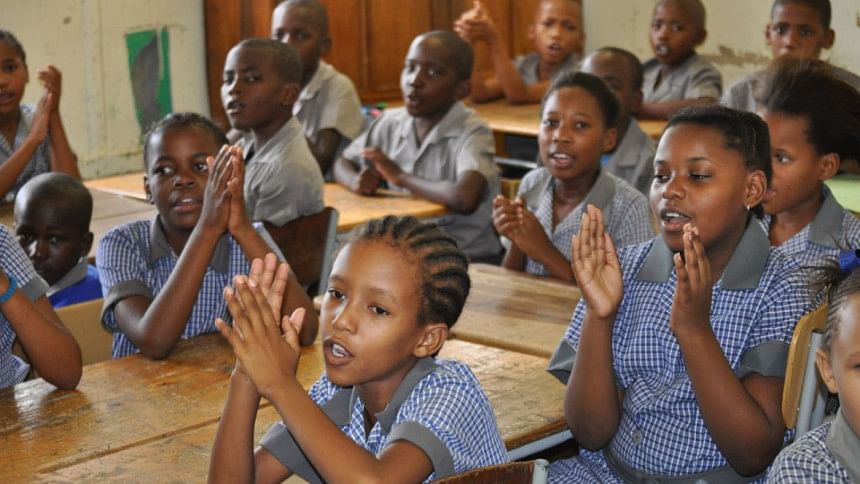Learning from Namibia

Sandwiched between Angola and South Africa, Namibia suffered mightily during the long struggle against apartheid. Yet, since winning independence from South Africa in 1990, this country of 2.4 million people has achieved enormous gains, especially in the last couple of years.
A big reason for Namibia's success has been the government's focus on education. While people in advanced countries take for granted free primary and secondary education, in many poor countries, secondary education, and even primary schools, require tuition. Indeed, governments are often advised to impose tuition as a form of "cost recovery." In Namibia, however, public primary education is free; and, as of the current school year, so is public secondary education.
Namibia's government is also proactive in other important ways. Malaria eradication efforts have reduced annual cases by 97 percent in about a decade. Bucking the global trend of increasing inequality, Namibia's Gini coefficient (the standard measure of inequality in an income distribution) has fallen by some 15 points since 1993 (admittedly from one of the highest levels in the world). And the poverty rate has been more than halved, from 69 percent in 1993 to under 30 percent, with extreme poverty (the number of people living on less than $1.90 a day) falling by a similar margin, from just under 53 percent to less than 23 percent.
Namibia also has Africa's highest ranking for press freedom from Reporters Without Borders – well ahead of the United States and other wealthy economies. The country also has favourable ratings – among the highest in Africa – on Transparency International's Corruption Perceptions Index.
Even as commodity prices have been falling, Namibia has managed to maintain strong GDP growth – an estimated 4.5 percent in 2015, following average growth of nearly 4.2 percent from 1991-2014. At the same time, its debt-to-GDP ratio, at around 25 percent, is less than a third of the debt ratio in Europe or the US.
Of course, Namibia has its problems. The unemployment rate, at least as conventionally measured, remains stubbornly high, at nearly 28 percent. And, like other countries in the region, it faces a high level of HIV/AIDS – nearly 17 percent of the population are HIV-positive.
The World Bank classifies Namibia as upper middle income, but the authorities insist that theirs is in fact a developing country. Namibia certainly has some of the difficulties we associate with less-developed economies. It has to develop a very large and arid country with a small population. This includes isolated desert communities of nomadic hunter-gatherers, who somehow must be integrated into a modern society without losing their identity.
Integrating people who a quarter-century ago were on the fringes of the global economy would be an enormous task for any country. For Namibia, it is even harder: as much as any country in the world, it is confronting head-on the effects of climate change.
Nonetheless, Namibia has taken these problems in stride as it creates a diversified economy and cohesive society. Remarkably, rival political factions of the country's freedom struggle have come together to work for the common good.
Indeed, Namibia provides low-cost health care not only for its own citizens, but also for its neighbors. Some 15-20% of health-care visits in the north of Namibia are Angolan citizens. The manager of the hotel where we stayed, just across the border, regularly sends a little boat across the crocodile-infested river to bring over Angolans who want to buy provisions at the hotel canteen or see the visiting Namibian health-care workers.
No one in Namibia talks about building a wall between their country and its poor and corrupt neighbors. Rather, the Namibians we met understand that you can't pick your neighbors, so it's best to work with them by sharing scarce water resources, cooperating on regional health efforts, encouraging investment, and exchanging students.
Moreover, Namibia's government has wisely understood that abundant natural resources can easily become a curse, enriching a few at the expense of the many. The authorities know that unless Namibia's natural wealth is invested in infrastructure and its people's productive capacities, resource exhaustion will leave the country poorer, not richer. They also know that it would be irresponsible not to garner for Namibians the most possible from the country's resources, and are rethinking investment laws and revisiting mining contracts to ensure that that is the case.
Transparency is crucial to this process, which is why the government's strong support of press freedom is so important. As President Hage Geingob told us, the press often says things that he doesn't like. But, having fought for freedom from apartheid South Africa, Geingob says, Namibia must defend the freedoms it won. Besides, Geingob recognizes how transparency protects him from demands for favors from corporate and other interest groups.
Not all of Namibia's key resources are finite. Some – like fisheries – are renewable, and the government is working hard to preserve and enhance them. Most important, unlike most other resource-dependent economies, it has succeeded in diversifying the economy – to the point that services account for more than 60 percent- of its GDP, with tourism leading the way. Every year, more than a million foreign tourists visit the country.
That is not surprising. Namibia is one of the most beautiful places in the world, and its people cultivate its environment and protect its animals. About 100 years ago, the colonialists – the "1 percent" of their time – enjoyed hunting for sport and decimated the rhino and elephant population. Now local scientists are bringing animals back to the Skeleton Coast and other parts of the country. Ironically, some funding for this comes from today's 1%, who donate to the cause.
Namibia shows that even countries that start with serious disadvantages – extremes of racism, colonialism, inequality, and underdevelopment – can chart a path toward shared prosperity. Its achievement deserves international recognition – and emulation.
Joseph E. Stiglitz, a Nobel laureate in economics, is University Professor at Columbia University and Chief Economist at the Roosevelt Institute. His most recent book is Rewriting the Rules of the American Economy. Anya Schiffrin is the director of the media and communications program at Columbia University's School of International and Public Affairs.
Copyright: Project Syndicate, 2016.
www.project-syndicate.org
(Exclusive to The Daily Star)

 For all latest news, follow The Daily Star's Google News channel.
For all latest news, follow The Daily Star's Google News channel. 







Comments